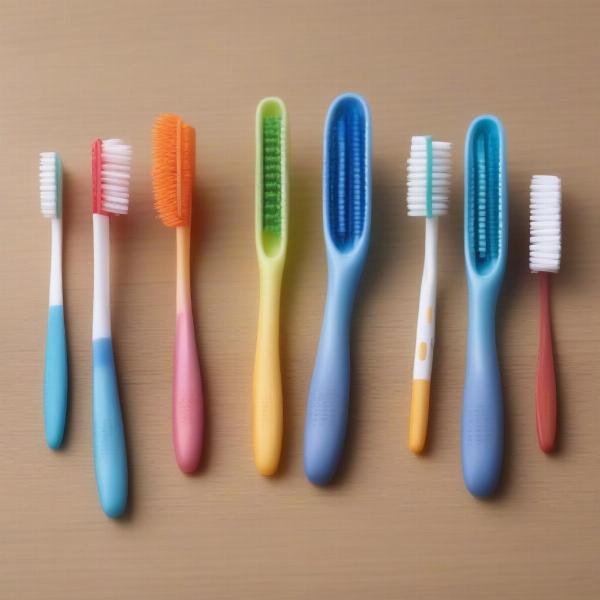Finger toothbrushes for dogs offer a gentle and effective way to maintain your canine companion’s oral hygiene. They are especially beneficial for puppies, senior dogs, or dogs with sensitive mouths. Using a finger toothbrush allows for greater control and precision, making it easier to reach those tricky spots in your dog’s mouth. In this guide, we’ll cover everything you need to know about finger toothbrushes for dogs, from choosing the right one to establishing a regular brushing routine.
Regular dental care is crucial for your dog’s overall health, and a finger toothbrush can be a valuable tool in your arsenal. It provides a more intimate and controlled cleaning experience, allowing you to target specific areas of your dog’s mouth. Choosing the right finger toothbrush and establishing a consistent routine are essential for maximizing its benefits. Let’s dive into the details of how to use a finger toothbrush effectively and ensure your furry friend has a healthy, happy smile.
Choosing the Right Finger Toothbrush for Your Dog
Selecting the right finger toothbrush depends on your dog’s size and breed. Smaller breeds might benefit from a more compact brush, while larger breeds may require a larger size. Consider the bristle material as well. Soft bristles are generally recommended, especially for dogs with sensitive gums. Look for toothbrushes specifically designed for dogs, as these are often made with more durable and safe materials. You can also find finger toothbrushes with added features like nubs or ridges for more effective plaque removal.
 Choosing the right finger toothbrush for dogs
Choosing the right finger toothbrush for dogs
Materials and Design Considerations
Opt for BPA-free materials to ensure your dog’s safety. Some finger toothbrushes come with antimicrobial properties, which can help prevent bacterial growth. The design should allow for a comfortable grip, making it easier for you to maneuver the brush effectively.
Establishing a Brushing Routine with a Finger Toothbrush
Introducing a finger toothbrush gradually is key. Start by letting your dog lick a small amount of dog-friendly toothpaste off your finger. Once they are comfortable with this, gently rub your finger along their gums and teeth. Gradually introduce the finger toothbrush, starting with short brushing sessions and gradually increasing the duration as your dog gets used to it.
Making Toothbrushing a Positive Experience
Positive reinforcement is crucial. Reward your dog with praise, treats, or a favorite toy after each brushing session. This helps create a positive association with teeth cleaning. Make the experience as relaxing as possible by choosing a quiet environment and speaking to your dog in a soothing voice.
Benefits of Using a Finger Toothbrush for Dogs
Finger toothbrushes offer several advantages over traditional dog toothbrushes. They provide better control, allowing for a more thorough cleaning. They are also ideal for dogs with sensitive mouths or those who are resistant to traditional brushing. The close contact allows you to feel for any abnormalities in your dog’s mouth, such as lumps or bumps.
Addressing Common Dental Issues in Dogs
Regular brushing with a finger toothbrush can help prevent plaque and tartar buildup, leading to healthier gums and fresher breath. It can also help prevent more serious dental issues like periodontal disease, which can affect your dog’s overall health.
Finger Toothbrushes for Specific Dog Needs
dog finger toothbrush can be particularly beneficial for puppies, senior dogs, and dogs with no teeth who require specialized oral care. Puppies are teething and getting them used to a finger toothbrush early can establish good dental habits. For senior dogs, a finger toothbrush is a gentler option.
“Establishing a regular dental routine with a finger toothbrush can significantly improve a dog’s quality of life,” says Dr. Emily Carter, DVM. “It’s a simple yet effective way to prevent painful dental conditions and promote overall well-being.”
Maintaining Your Dog’s Oral Hygiene Beyond Brushing
While brushing is essential, other products like dental rinse for dogs and plaque remover for dogs can complement your efforts. Dental chews and toys can also help keep your dog’s teeth clean between brushings. “Remember that regular veterinary checkups are also essential for maintaining your dog’s oral health,” adds Dr. Carter. “Your vet can identify any potential issues early on and recommend the best course of action.”
Conclusion
Finger toothbrushes for dogs provide a practical and effective solution for maintaining optimal oral hygiene. By choosing the right brush, establishing a consistent routine, and incorporating other dental care practices, you can help ensure your furry friend enjoys a healthy and happy smile for years to come. Remember, a healthy mouth contributes to a healthy dog. Start incorporating a finger toothbrush into your dog’s routine today!
FAQ
- How often should I use a finger toothbrush on my dog? Ideally, daily brushing is recommended.
- What type of toothpaste should I use with a finger toothbrush? Always use toothpaste specifically formulated for dogs. Human toothpaste can be toxic to dogs.
- Can I use a finger toothbrush on a puppy? Yes, finger toothbrushes are ideal for puppies and can help them get accustomed to regular brushing.
- My dog resists the finger toothbrush. What should I do? Be patient and introduce the toothbrush gradually, using positive reinforcement.
- Are there any alternatives to finger toothbrushes for dogs? Yes, traditional dog toothbrushes, dental chews, and dental sprays are available.
- How do I know if my dog has dental problems? Signs of dental problems include bad breath, red or swollen gums, and difficulty eating.
- Can I use a human finger toothbrush on my dog? No, it’s best to use a toothbrush specifically designed for dogs.
ILM Dog is your trusted international resource for dog care and upbringing. We offer expert guidance on breeds, health, training, nutrition, grooming, and much more. From choosing the perfect breed to providing the best possible care for your senior dog, ILM Dog covers every aspect of responsible dog ownership. Contact us for expert advice: Email: [email protected], Phone: +44 20-3965-8624.